Did you know that Brunei Darussalam, a small country on the northwest coast of Borneo, is home to an astonishing 15,000 species of vascular plants? With its rich biodiversity and numerous sacred natural sites, Brunei is a hidden gem for nature enthusiasts and conservationists alike.
Brunei’s natural vegetation consists primarily of tropical evergreen rainforests, covering a staggering 81% of the country’s land area. Within these lush forests, you’ll find 2,000 species of trees and a diverse array of wildlife. Brunei’s mangroves, the largest remaining intact mangroves in northern Borneo, play a crucial role in the coastal ecosystem and serve as sanctuaries for various marine species.
However, Brunei’s biodiversity faces numerous threats, including land development, pollution, invasive alien species, and climate change. Despite these challenges, the country has implemented policies, laws, and conservation programs to protect and preserve its natural sites.
Key Takeaways
- Brunei Darussalam is home to an estimated 15,000 species of vascular plants, showcasing its incredible ecological diversity.
- The country’s tropical rainforests, covering 81% of the land area, provide habitat for a vast array of flora and fauna.
- Brunei’s mangroves are the largest remaining intact mangroves in northern Borneo, serving as vital ecosystems for coastal biodiversity.
- Threats to Brunei’s biodiversity include land development, pollution, invasive species, and the impacts of climate change.
- Efforts have been made to conserve and protect Brunei’s natural sites through policies, laws, and conservation programs.
Luagan Lalak Recreational Park
Luagan Lalak Recreational Park is a stunning nature reserve located in Brunei. Spanning almost 270 hectares, this park is renowned for its breathtaking freshwater swamp, attracting visitors from near and far.
The park offers a unique experience with its network of concrete walkways that meander through the lush surroundings. As visitors explore, they have the opportunity to observe the diverse flora and fauna that call this park home.
“Luagan Lalak Recreational Park allows visitors to immerse themselves in the beauty of Brunei’s nature while providing a sanctuary for various bird and fish species,” says park ranger, Sarah Thompson.
One of the park’s highlights is its freshwater swamp, an enchanting sight that reveals itself during the dry season. As the water recedes, it uncovers a captivating field of Lepironia sedges, creating a picturesque landscape. Visitors can witness this fascinating transformation and capture stunning photographs of the natural beauty that surrounds them.
Luagan Lalak Recreational Park is also a haven for wildlife enthusiasts. Birdwatchers can spot a variety of bird species soaring through the sky or perched on tree branches. Meanwhile, fish species swim gracefully in the park’s freshwater ecosystem, enhancing the overall charm of the park.
The park’s serene location in Labi, approximately 2 hours away from the capital city of Bandar Seri Begawan, provides an escape from the hustle and bustle of urban life. Visitors can revel in the tranquillity of nature, enjoy a leisurely stroll along the walkways, and truly connect with the natural wonders that Brunei has to offer.
With its captivating freshwater swamp, diverse wildlife, and serene atmosphere, Luagan Lalak Recreational Park is a must-visit destination for nature lovers and those seeking an immersive experience in Brunei’s natural beauty.
Mangrove River Safari
The Mangrove River Safari is a must-do experience in Brunei for nature lovers. This safari allows visitors to explore the country’s stunning mangroves and encounter its unique wildlife. Departing from the Bandar Seri Begawan waterfront, the Mangrove River Safari offers a memorable excursion just outside the bustling city.
During the safari, visitors embark on a boat journey through Brunei’s expansive mangrove forests, which are known as one of the largest and most well-preserved mangrove ecosystems in northern Borneo. These mangroves play a vital role in the coastal ecosystem, providing habitat for a wide range of plant and animal species.
As you cruise through the serene mangrove waterways, keep your eyes peeled for crocodiles basking in the sun and birds soaring overhead. One of the highlights of the Mangrove River Safari is the opportunity to spot the iconic Proboscis Monkeys. These mesmerizing creatures, with their large noses and distinctive appearance, can often be seen foraging and leaping between the trees along the riverbanks.
Immerse yourself in the natural beauty of Brunei’s mangroves as you witness the harmony between the lush greenery and the wildlife that calls it home.
Throughout the safari, knowledgeable guides provide fascinating insights and information about the mangroves and the importance of their preservation. They highlight the unique adaptations of the wildlife that thrive in this coastal habitat and emphasize the ecological significance of mangroves in maintaining a healthy and balanced ecosystem.
The Mangrove River Safari offers a peaceful respite from the city and allows visitors to appreciate the tranquil beauty of Brunei’s mangroves. It is a truly immersive experience that leaves a lasting impression and a deeper understanding of the remarkable natural wonders that Brunei has to offer.
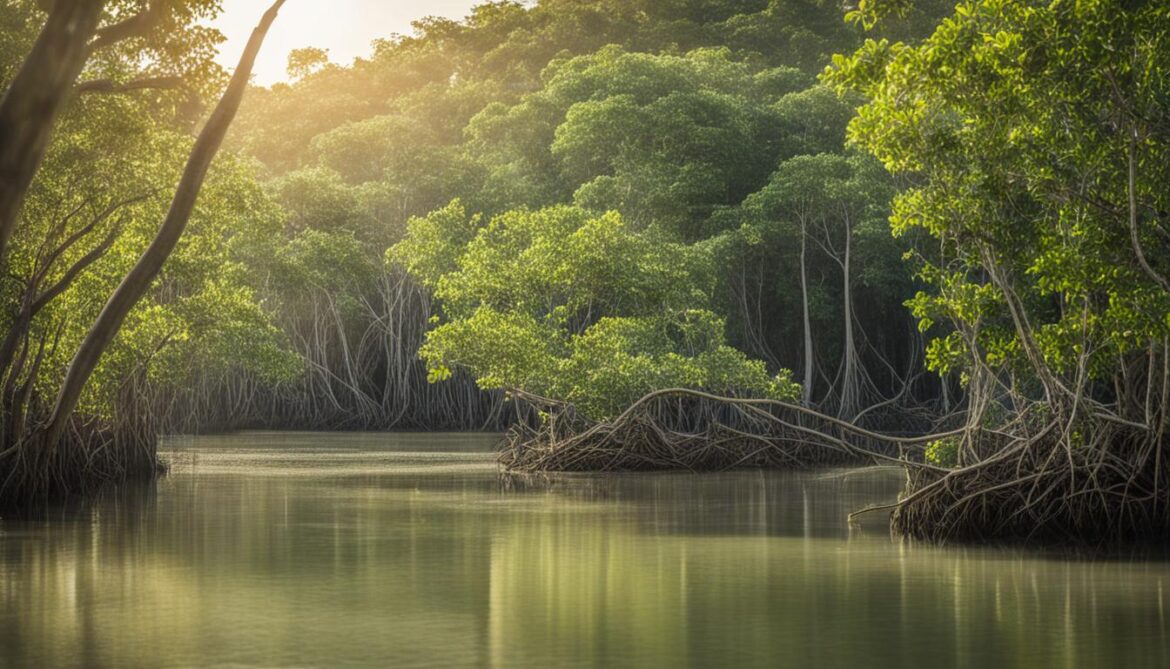
Why Choose the Mangrove River Safari?
The Mangrove River Safari stands out as an exceptional opportunity to explore Brunei’s wildlife sanctuaries. Here are some reasons why it should be on every nature enthusiast’s itinerary:
- Encounter diverse wildlife: From crocodiles to Proboscis Monkeys, the mangroves are home to a fascinating array of species.
- Learn from knowledgeable guides: Gain valuable insights about the mangroves’ ecological importance and the unique adaptations of its inhabitants.
- Immerse in natural beauty: Escape the city and immerse yourself in the serene and picturesque mangrove environment.
- Contribute to conservation efforts: By participating in the Mangrove River Safari, you support the conservation of Brunei’s mangroves and its wildlife sanctuaries.
- Create lasting memories: The Mangrove River Safari offers a memorable experience that will leave you with cherished memories of Brunei’s natural wonders.
Ulu Temburong National Park
Ulu Temburong National Park is a pristine nature reserve located in the Temburong District of Brunei. Covering 212 square miles, the park is known for its incredible biodiversity and breathtaking waterfalls. It is home to approximately 400 types of butterflies, making it a paradise for butterfly enthusiasts.
One of the main attractions in Ulu Temburong National Park is the Ulu Mutong Waterfalls, also known as the Garra Rufa fish home. Visitors can wade into the waterfalls and experience a natural spa as the tiny freshwater fish nibble on their feet and legs.
“Ulu Temburong National Park offers a unique opportunity to immerse oneself in Brunei’s natural beauty and witness its diverse flora and fauna.”
The park is filled with lush greenery and vibrant wildlife, creating a mesmerizing experience for nature lovers. From towering trees to colorful orchids, the flora in Ulu Temburong National Park is diverse and enchanting. Visitors can spot unique species of birds, insects, and mammals as they explore the park’s trails.
In addition to its biodiversity, Ulu Temburong National Park is also known for its pristine waterways and stunning waterfalls. The Ulu Mutong Waterfalls provide a tranquil and refreshing atmosphere, allowing visitors to reconnect with nature and find inner peace.
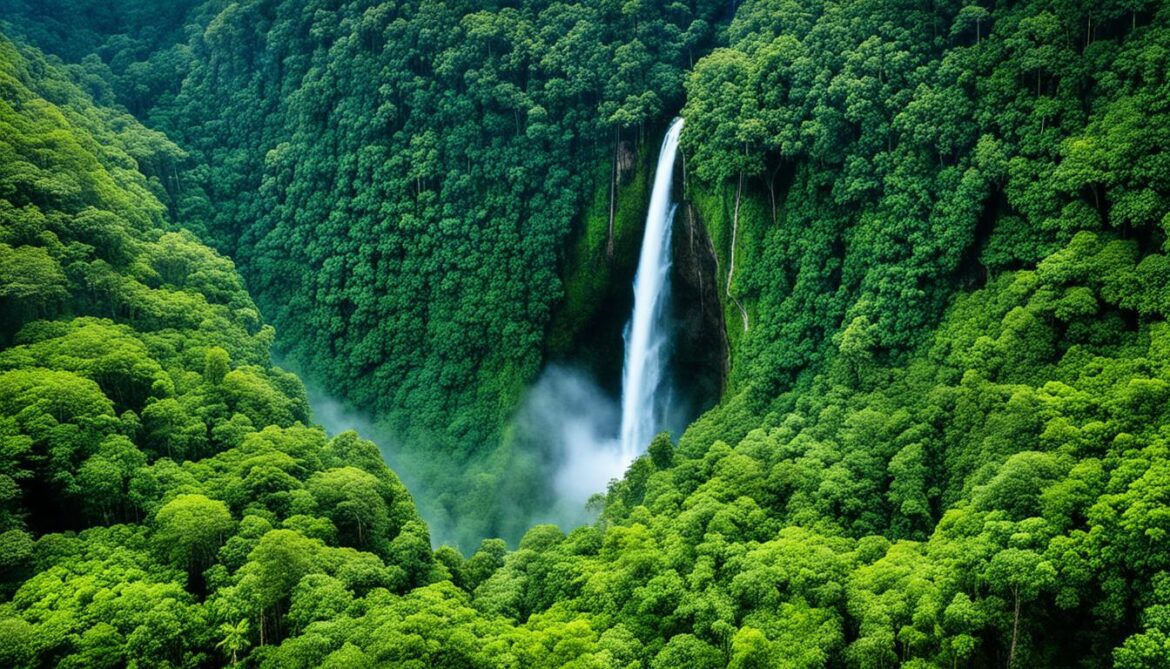
Wildlife Found in Ulu Temburong National Park
| Animal |
Description |
| Hornbill |
A magnificent bird with a large curved bill, known for its vibrant colors and loud calls. |
| Proboscis Monkey |
A unique primate species with a distinctive long nose and potbelly, found exclusively in Borneo. |
| Rajah Brooke’s Birdwing |
The national butterfly of Brunei, featuring stunning black wings with bright green highlights. |
| Sunda Pygmy Elephant |
A small subspecies of Asian elephant, known for its playful behavior and gentle nature. |
| Binturong |
A nocturnal mammal also known as the “bearcat,” characterized by its long bushy tail and prehensile abilities. |
Cardamom Mountains
The Cardamom Mountains, spanning over 10 million acres, is the largest rainforest in Southeast Asia and an awe-inspiring natural wonder in western Cambodia. Its lush landscapes and diverse wildlife make it a must-visit destination for nature enthusiasts and adventure seekers.
Home to a wide range of plant and animal species, including some that are endangered, the Cardamom Mountains are a haven for biodiversity. Within its breathtaking rainforest, visitors may have the chance to encounter majestic elephants, elusive clouded leopards, adorable sun bears, and even Siamese crocodiles, among other fascinating wildlife.
For those seeking active exploration, the mountains offer a range of activities such as kayaking, hiking, and swimming. Whether you choose to navigate the pristine rivers by kayak, embark on a thrilling hike through the dense foliage, or take a refreshing dip in the crystal-clear waters, the Cardamom Mountains provide endless opportunities to immerse yourself in Cambodia’s natural wonders.
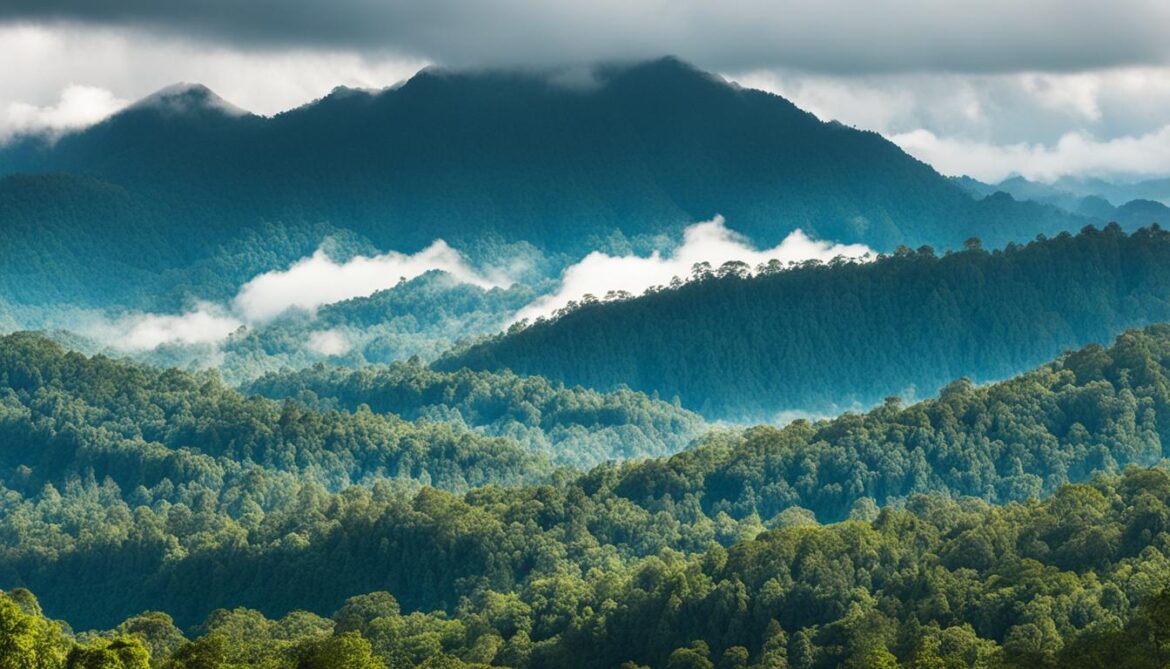
Not only does a visit to the Cardamom Mountains offer a chance to appreciate the beauty of Cambodia’s rainforest, but it also serves as a powerful reminder of the importance of wildlife conservation. The vast expanse of the mountains is inhabited by approximately 25,000 people, primarily ethnic minorities, who have a deep connection to the land and its resources.
Cambodia’s commitment to wildlife conservation is highlighted by the preservation of the Cardamom Mountains. Through various conservation efforts and initiatives, the country strives to protect the rich biodiversity found within this natural marvel.
The Cardamom Mountains stand as a testament to Cambodia’s dedication to sustainable ecotourism and the preservation of its natural heritage. As you journey through the verdant rainforest and witness the wonders it holds, you are not only embarking on an unforgettable adventure but also contributing to the ongoing efforts of wildlife conservation in Cambodia.
Bungalow Kampot River
Bungalow Kampot River is a picturesque destination in Cambodia that offers a unique experience of the country’s aquatic ecosystems. Accessible by kayak or paddleboat, the Kampot River is lined with mangroves and small fishing villages. Visitors can explore the river at their own pace and marvel at the surrounding scenery, including pepper plantations and salt fields.
This intimate experience allows visitors to gain a deeper understanding of Cambodia’s ecosystem and its close connection to the livelihood of the local communities.
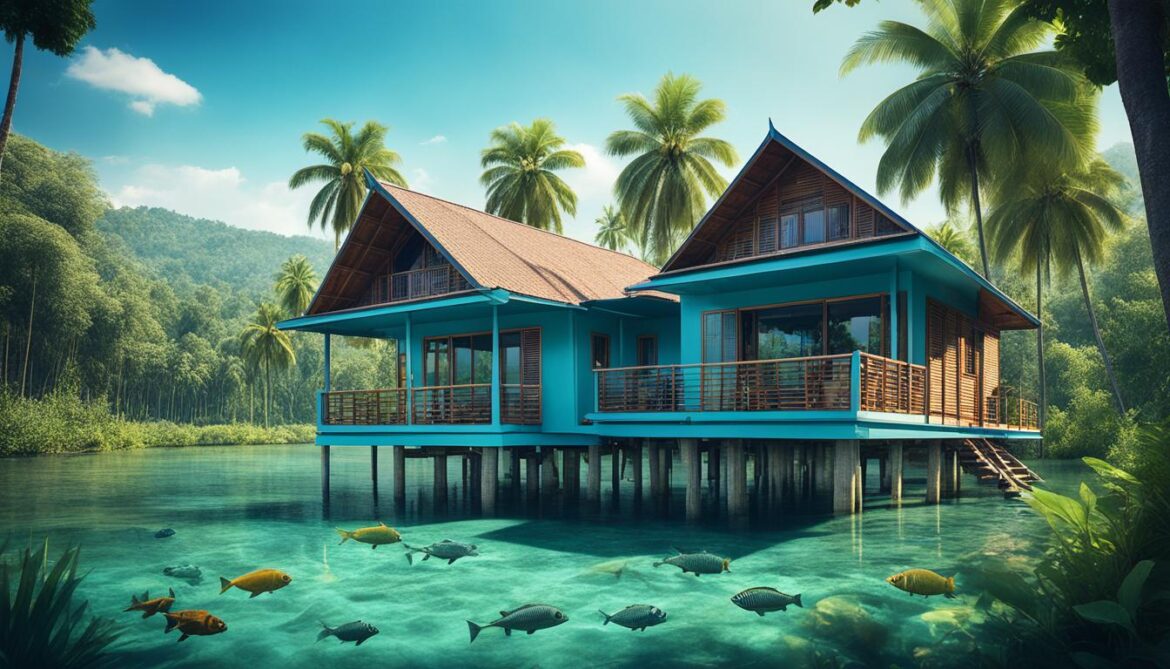
As you paddle along the Kampot River, you’ll encounter lush mangrove forests that thrive in the brackish waters, creating a vital habitat for diverse marine species and supporting the overall health of the ecosystem. The intricate network of interlacing roots provides a sanctuary for juvenile fish, crustaceans, and other aquatic organisms, forming the foundation of Cambodia’s aquatic biodiversity.
Furthermore, the river is dotted with charming fishing villages where locals continue their traditional way of life, relying on the rich resources the river provides. You can witness the vibrant culture and witness the age-old fishing techniques passed down through generations. Engaging with the local communities offers a glimpse into their lifestyle and deepens your appreciation for the delicate balance of the aquatic ecosystems and the human-nature interdependence.
Exploring Bungalow Kampot River
When visiting Bungalow Kampot River, you have the freedom to choose your adventure. Here are some activities you can enjoy:
- Guided kayak tours: Join a knowledgeable guide who will navigate you through the meandering river channels, pointing out important wildlife sightings and sharing fascinating insights about the mangrove ecosystem.
- Paddleboat rides: Opt for a relaxing paddleboat ride along the calm river, allowing you to immerse yourself in the scenery and take in the tranquility of the surroundings.
- Photography opportunities: Capture stunning images of the lush mangroves, traditional fishing boats, and the local fishing communities engaged in their daily activities. The natural beauty and unique cultural aspects provide endless photo opportunities.
- Birdwatching: Keep an eye out for a variety of bird species that call the mangroves home, including egrets, kingfishers, and herons. Binoculars and a keen eye will enhance your birdwatching experience.
Whether you’re a nature enthusiast, a wildlife lover, or simply seeking a peaceful retreat, Bungalow Kampot River offers a memorable experience filled with natural beauty, cultural encounters, and a deeper understanding of Cambodia’s aquatic ecosystems.
Lake Yeak Laom
Lake Yeak Laom is a natural wonder located approximately three miles from Banlung in Cambodia. Formed by a volcanic explosion around 4,000 years ago, this enchanting lake sits within a perfectly circular crater, creating a tranquil and serene environment. Surrounded by lush trees and local villages, Lake Yeak Laom holds sacred significance for the local community. While visitors are welcome to swim in the lake, activities that disrupt its peaceful atmosphere, such as arguments and gambling, are prohibited.
Lake Yeak Laom is renowned for its abundant wildlife, making it a haven for nature enthusiasts. The lake is home to a variety of exotic bird species and vibrant butterflies fluttering among the trees. The harmonious blend of breathtaking natural beauty and vibrant wildlife creates a perfect setting for visitors to relax and appreciate Cambodia’s captivating landscapes.
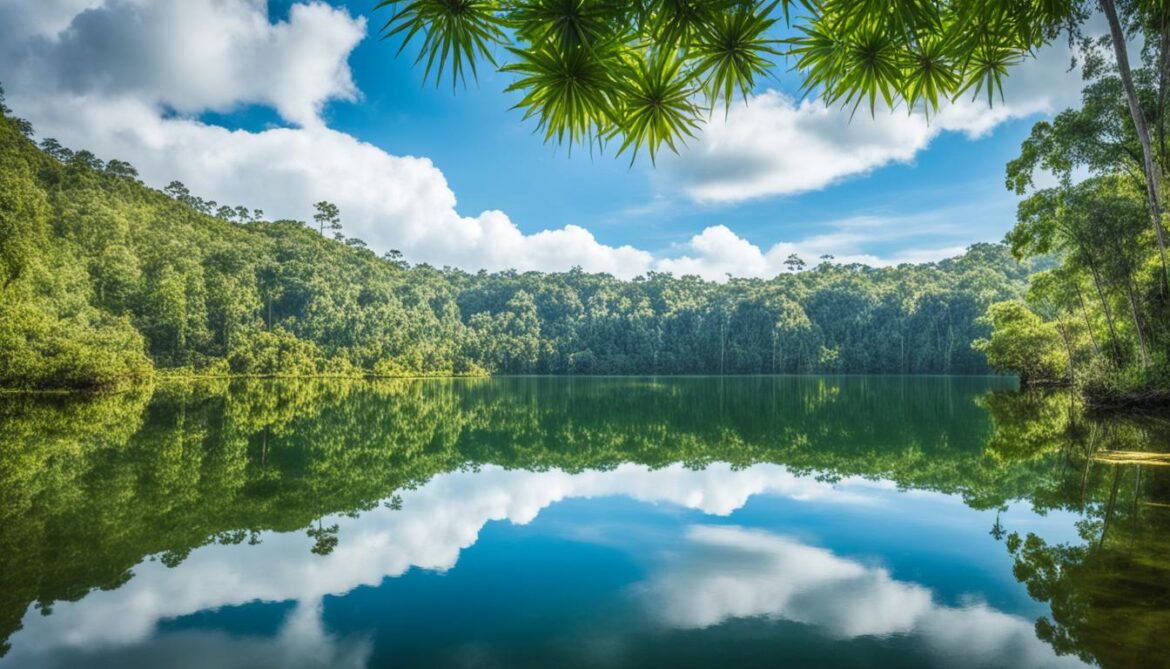
Quotes
“Visiting Lake Yeak Laom was a truly restorative experience. The peaceful atmosphere and stunning surroundings made it a perfect escape from the hustle and bustle of everyday life.” – Emma, UK
“The abundance of wildlife at Lake Yeak Laom was astounding. I felt privileged to witness such natural beauty and see the vibrant birdlife and colorful butterflies in their natural habitat.” – John, Australia
Lake Yeak Laom – At A Glance
| Location |
Approximately three miles from Banlung, Cambodia |
| Formation |
Volcanic explosion around 4,000 years ago |
| Shape |
Perfectly circular crater |
| Activities |
Swimming (prohibited activities: arguments, gambling) |
| Wildlife |
Exotic birds and vibrant butterflies |
Lake Yeak Laom is a hidden gem in Cambodia, offering a peaceful retreat amidst stunning natural surroundings. Visitors can immerse themselves in the tranquility of this crater lake and witness the diverse wildlife that calls it home. A visit to Lake Yeak Laom is a chance to experience the beauty of Cambodia’s natural wonders firsthand.
Bokor National Park
Bokor National Park is a unique destination in Cambodia that offers a captivating blend of natural beauty and historical sites. Originally established as a French hill station in the 1920s, the park holds a rich history but was later abandoned during World War II and the Khmer Rouge period. Today, it stands as a protected area, providing visitors with a remarkable insight into Cambodia’s past and showcasing its impressive biodiversity.
Nestled within Bokor National Park is a diverse range of wildlife, including elusive leopard cats, majestic hornbills, and adorable sun bears. Exploring the park’s verdant trails allows visitors to immerse themselves in Cambodia’s natural wonders while encountering these fascinating creatures in their natural habitat.
“Bokor National Park is not only a testament to Cambodia’s history, but it also serves as a sanctuary for some of the country’s most remarkable wildlife.”
Enthusiasts of history and nature will find delight in Bokor National Park’s unique attractions. The park is home to several well-preserved historic buildings, including the Bokor Palace Hotel and the Old Catholic Church, which transport visitors back in time to the colonial era. The breathtaking scenery surrounding these structures offers a picturesque backdrop, making it an ideal spot for photography enthusiasts.
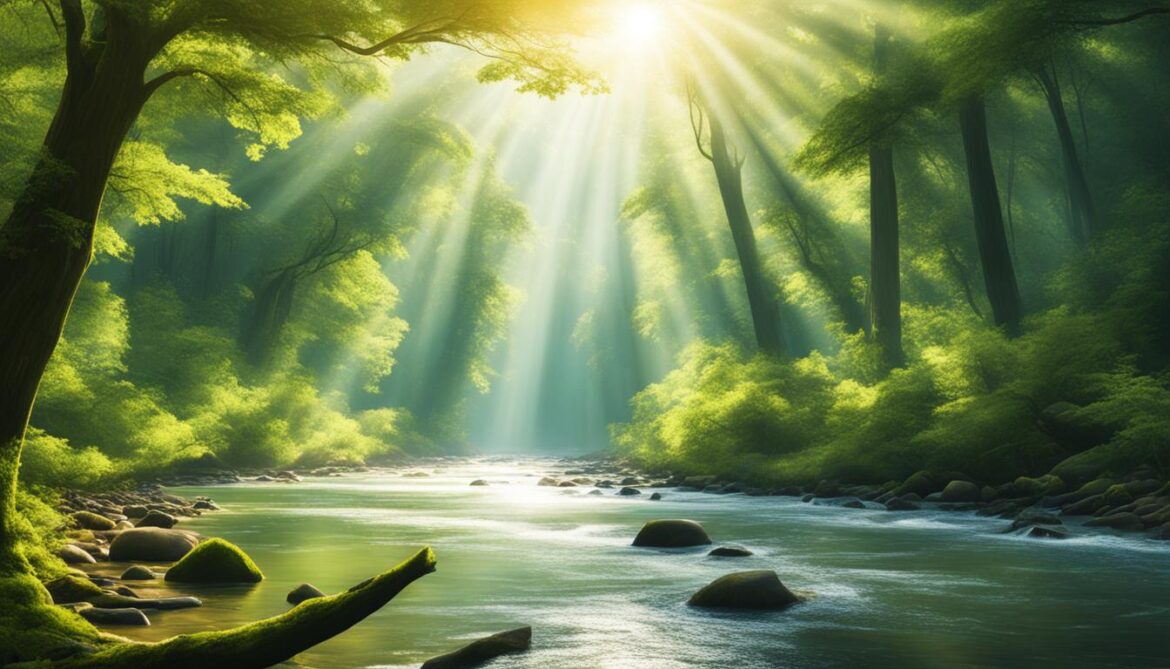
Bokor National Park provides an immersive experience that caters to the interests of both history buffs and nature lovers. Whether marveling at the remnants of Cambodia’s intriguing past or exploring the diverse ecosystems teeming with wildlife, a visit to Bokor National Park offers a truly unforgettable experience.
| Highlights of Bokor National Park |
Wildlife Encounters |
Historic Buildings |
| 1. Pristine natural beauty |
1. Elusive leopard cats |
1. Bokor Palace Hotel |
| 2. Breathtaking landscapes |
2. Majestic hornbills |
2. Old Catholic Church |
| 3. Abundant wildlife |
3. Adorable sun bears |
3. Historical photo opportunities |
Plan your visit to Bokor National Park and embark on a journey that intertwines Cambodia’s natural wonders with its fascinating history. Whether you’re an avid wildlife enthusiast or a curious explorer, this unique destination is sure to leave a lasting impression.
Importance of TEK in Biodiversity Conservation
Traditional Ecological Knowledge (TEK) has a crucial role to play in the conservation of biodiversity in both Brunei and Cambodia. Indigenous peoples in these regions have relied on their traditional knowledge for generations to responsibly manage natural resources and protect the delicate balance of ecosystems.
TEK is a perpetual and cumulative body of knowledge and beliefs that explain the intricate relationship between living beings and their environment. Passed down orally through generations, this knowledge holds invaluable insights into sustainable practices that conserve biodiversity and maintain ecological harmony.
In Brunei, TEK is particularly vital in the conservation and management of sacred natural sites and protected areas. The indigenous communities possess intricate knowledge of these areas, allowing them to employ responsible practices that preserve the ecological integrity of these sites.
Cambodia, on the other hand, leverages TEK in various aspects of natural resource management. Indigenous communities’ knowledge supports sustainable agriculture practices, helps mitigate and manage disasters, and contributes to the provision of weather services for the agricultural sector.
Integrating TEK into biodiversity conservation efforts is crucial in achieving sustainable development goals and ensuring the long-term preservation of Brunei’s and Cambodia’s rich biodiversity.
Embracing TEK acknowledges the profound wisdom embedded within indigenous cultures and their deep understanding of the natural world. By collaborating with indigenous communities and incorporating their knowledge, conservation efforts can be enhanced, contributing to the protection and sustainable management of Brunei’s conservation areas and Cambodia’s wildlife sanctuaries.
Conclusion
In conclusion, both Brunei and Cambodia possess an impressive array of natural wonders and biodiverse landscapes. Brunei boasts its sacred natural sites that showcase the country’s ecological diversity, while Cambodia is renowned for its captivating natural wonders, such as the Cardamom Mountains.
One crucial aspect of biodiversity conservation in these countries is the recognition and integration of Traditional Ecological Knowledge (TEK). The indigenous communities in Brunei and Cambodia possess invaluable wisdom and practices that contribute to the protection and sustainable management of their natural resources.
By harnessing and incorporating TEK into their conservation efforts, Brunei and Cambodia can effectively preserve their sacred natural sites, promote sustainable development, and ensure the long-term survival of their unique ecosystems and wildlife. Thus, fostering a harmonious coexistence between humans and the natural world for generations to come.
FAQ
What is the importance of Brunei’s sacred natural sites and biodiversity?
Brunei’s sacred natural sites and biodiversity are important because they represent the country’s rich ecological diversity and serve as habitats for numerous plant and animal species.
What percentage of Brunei’s land area is covered by tropical evergreen rainforests?
Approximately 81% of Brunei’s total land area is covered by tropical evergreen rainforests.
How many species of vascular plants can be found in Brunei’s rainforests?
Brunei’s rainforests are estimated to be home to 15,000 species of vascular plants, including 2,000 species of trees.
What is the significance of Brunei’s mangroves?
Brunei’s mangroves are the largest remaining intact mangroves in northern Borneo and play a crucial role in the coastal ecosystem.
What are the threats to Brunei’s biodiversity?
Brunei’s biodiversity faces threats such as land development, pollution, invasive alien species, and climate change.
How is Brunei conserving its natural sites?
Brunei is conserving its natural sites through policies, laws, and conservation programs aimed at protecting and preserving biodiversity.
What is Luagan Lalak Recreational Park known for?
Luagan Lalak Recreational Park is known for its stunning freshwater swamp and diverse flora and fauna.
Where is Luagan Lalak Recreational Park located?
Luagan Lalak Recreational Park is located in Labi, approximately 2 hours away from the capital city of Bandar Seri Begawan in Brunei.
What can visitors experience at the Mangrove River Safari?
Visitors can explore Brunei’s mangroves, observe wildlife such as crocodiles and Proboscis Monkeys, and appreciate the importance of mangroves in the coastal ecosystem during the Mangrove River Safari.
Where does the Mangrove River Safari depart from?
The Mangrove River Safari departs from the Bandar Seri Begawan waterfront in Brunei.
What makes Ulu Temburong National Park unique?
Ulu Temburong National Park is known for its incredible biodiversity, breathtaking waterfalls, and the opportunity to experience a natural spa by wading into the Ulu Mutong Waterfalls.
How many types of butterflies can be found in Ulu Temburong National Park?
Ulu Temburong National Park is home to approximately 400 types of butterflies, making it a paradise for butterfly enthusiasts.
Where is Ulu Temburong National Park located?
Ulu Temburong National Park is located in the Temburong District of Brunei.
What is the Cardamom Mountains known for?
The Cardamom Mountains in Cambodia are known for being the largest rainforest in Southeast Asia and being home to a diverse range of plant and animal species.
What activities can visitors participate in at the Cardamom Mountains?
Visitors to the Cardamom Mountains can engage in activities such as kayaking, hiking, and swimming while observing wildlife such as elephants, sun bears, and clouded leopards.
What makes Bungalow Kampot River a unique destination in Cambodia?
Bungalow Kampot River offers visitors the opportunity to explore Cambodia’s aquatic ecosystems, including mangroves and fishing villages, by kayak or paddleboat.
Where is Bungalow Kampot River located?
Bungalow Kampot River is located along the Kampot River in Cambodia.
What is Lake Yeak Laom known for?
Lake Yeak Laom is known for its serene and peaceful environment, its circular crater shape, and its abundance of exotic birds and butterflies.
What is prohibited at Lake Yeak Laom?
Activities such as arguments and gambling are prohibited at Lake Yeak Laom to preserve its tranquility.
What can visitors see at Bokor National Park?
Visitors to Bokor National Park can explore Cambodia’s natural wonders, including its diverse wildlife and historical sites from its past as a French hill station.
How does Traditional Ecological Knowledge (TEK) contribute to biodiversity conservation?
Traditional Ecological Knowledge (TEK) plays a significant role in biodiversity conservation by incorporating indigenous peoples’ valuable knowledge and practices in sustainable natural resource management.
Source Links






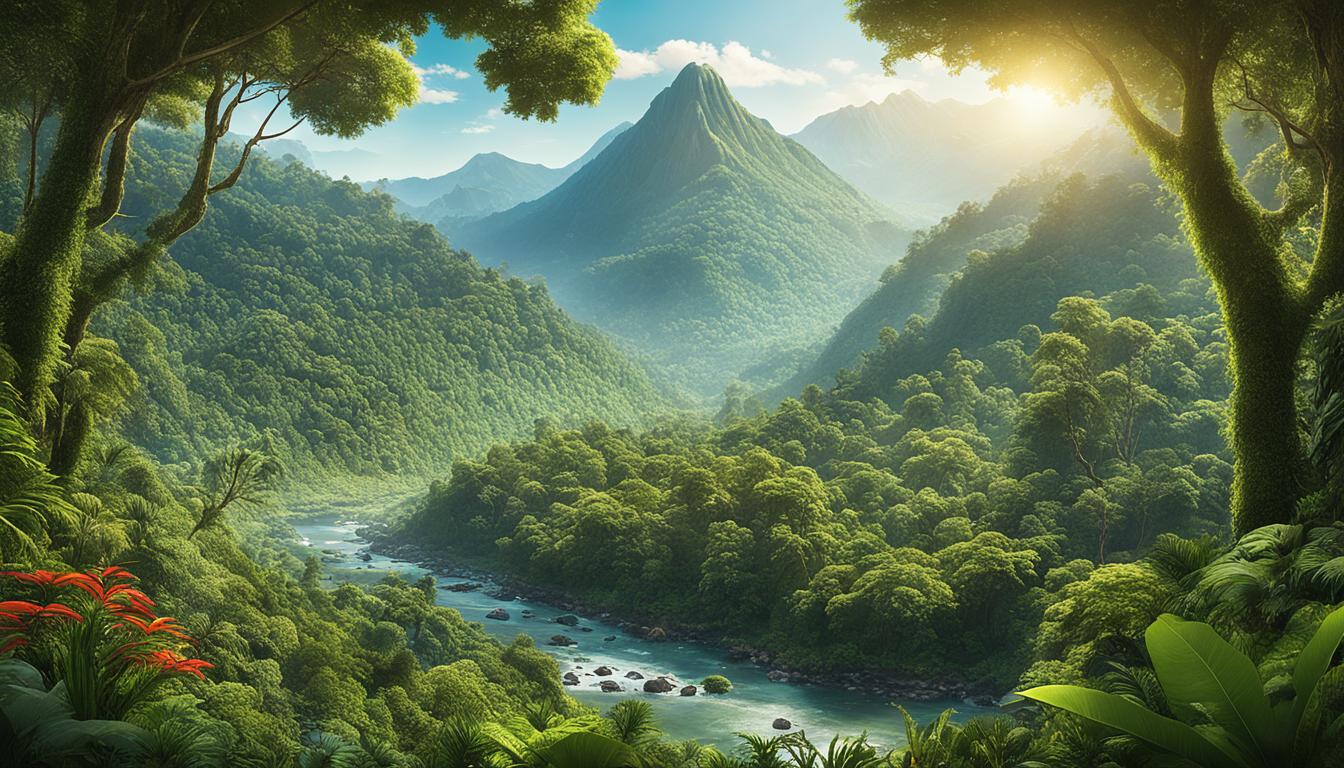

















Post comments (0)